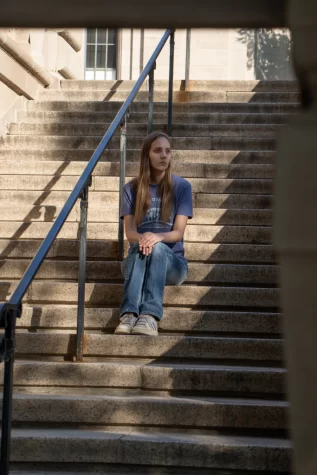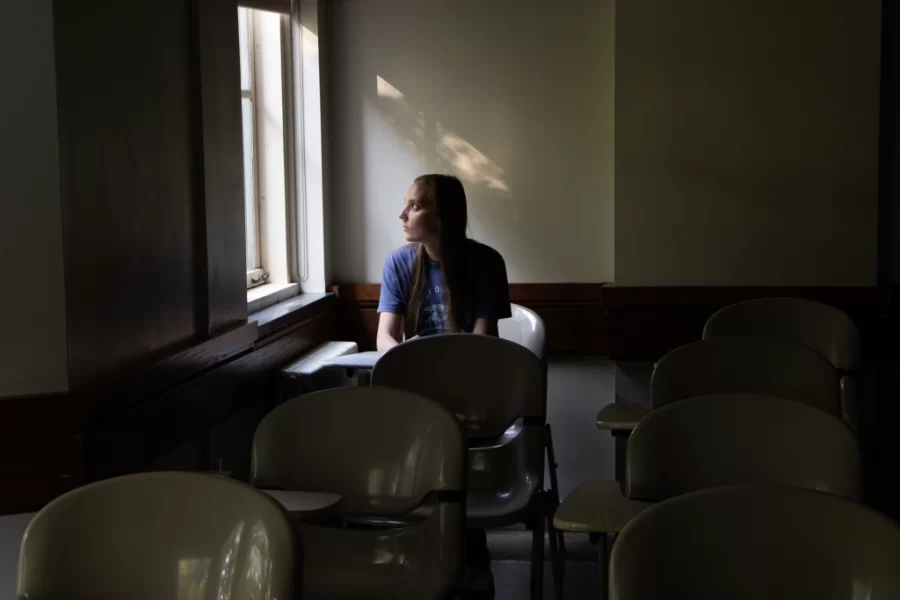The high cost of higher ed: Pitt is one of the nation’s priciest public universities for local families
Even with financial aid, Pitt families pay more than those nationwide who send their children to their university next door.
June 5, 2023
For Aaron Conrad, being able to attend the University of Pittsburgh as an in-state student meant having to work full time on top of his full-time studies. Some months, it even meant going to food banks.
Conrad, who lives in Bridgeville, graduated from Pitt this spring. Before he enrolled, he had done “as much money-crunching” as possible to reduce his cost of attendance. He participated in an early college program while in high school, allowing him to earn an associate’s degree upon graduation in 2019.
Still, Conrad, who enrolled at Pitt in fall 2021, feels that the debt he has accumulated from his Pitt education is “daunting.” Over two years, he took out about $14,500 in federal loans.
“Multiple times throughout my college experience, I’ve had thoughts where I’d have to drop out because I wouldn’t be able to afford it,” he said.
Public universities provide lower tuition for in-state residents, but that discount doesn’t go as far at Pitt. The university’s average price of attendance for local families is one of the highest in the country, partly because of downward-trending state investment in public higher education.
Using data from the U.S. Department of Education, PublicSource and The Pitt News compared the cost of attendance at Pitt to the 34 other leading public research universities in the nation. Pitt’s estimated in-state tuition and fees were the most expensive, totaling $21,080 in the 2022-2023 academic year. That excludes the additional costs of textbooks, supplies, housing and food, which brought the total price to, at most, $37,028.
While roughly half of Pitt families receive financial aid to reduce that sticker price, they’re still shelling out more than most. The university’s average net price of attendance – which factors in aid – was the second-most expensive of that group of leading public research universities as of the 2020-21 academic year, the most recent year for which data was available. The Pennsylvania State University was the most expensive.
These numbers can add up over four years. Families at Pitt pay, on average, about $23,000 a year. Those at other top public research universities pay less — at the Georgia Institute of Technology, for instance, families pay around $17,360 a year, on average.
Public universities are regional economic drivers and gateways of opportunity, but rising tuition costs threaten that public good. They can prevent low-income students from enrolling or saddle them with debt. They can burden middle-class students, who must cover particularly high costs in Pennsylvania while typically receiving less need-based aid. They can leave the region searching for qualified, college-educated workers if residents choose not to pursue a degree due to the cost.
Nearly every public university is cheaper than Pitt for middle-class families looking to send their children to a college close to home.
For a Michigan family making $60,000 a year, an education at Michigan State University is roughly half the price of Pitt. That’s true, too, at the University of North Carolina at Chapel Hill. At the University of Washington’s Seattle campus, the state’s families of that income level pay about 70% less than they would at Pitt. At Purdue University, families in Indiana pay about 80% less – only $4,645.
Low-income families also pay more at Pitt. An in-state family earning less than $30,000 a year pays $15,534 at Pitt but $11,559 at The University of Texas at Austin; $7,759 at The Ohio State University; $3,753 at the University of Wisconsin-Madison; and just $129 at Michigan State.
Nearly two-thirds of undergraduates at Pitt’s main campus are from Pennsylvania, and about 20% are from Allegheny County. Public universities help make higher education accessible to residents, but unaffordable tuition costs can also strain that relationship, said Kimberly Dancy, associate director of research and policy at the Institute for Higher Education Policy.
College towns “tend to be strong employers and provide significant opportunities in the community,” Dancy said. “It can really create problems in terms of the relationships between the residents of those states if they’re not … being provided with opportunities to benefit.”
A cross-country switch to save money
Kimberly Casella, of Bridgeville, took out a private loan to afford a semester at Pitt. Having first attended the Community College of Allegheny County to save money on tuition, Casella transferred to Pitt in spring 2019.

Casella did not receive any financial aid for her first semester. Her household financial situation had worsened, but financial aid did not rise to fill the gap. She took out a $14,000 private loan from Sallie Mae, hopeful that she would receive financial aid the following semester.
But once the fall semester rolled around, Casella again did not receive financial aid. She had to withdraw from the university, halfway through classes.
“It was actually very heartbreaking. I kind of mourned that a little bit,” Casella said. “Being first-generation and not having the best health or track record with school, getting into Pitt was such a milestone for me, and I was extremely proud to attend the university.”
After leaving Pitt, Casella went to the public Oregon State University, where she will graduate this summer. She was able to receive financial aid, and even as an out-of-state student, Casella has found the university to be more affordable than Pitt. But she still bears the financial burden of the private loan she took out for Pitt. With interest, she owed roughly $18,400 as of late May, despite making monthly payments.
“That is probably never going to get paid off,” Casella said. “I don’t want other people to get trapped into a Sallie Mae loan as I did.”
A funding struggle in Pennsylvania
Pitt is able to offer its in-state discount because it receives an annual appropriation of state funding. But from 2008 to 2019, Pennsylvania’s per-student funding of higher education fell by roughly a third, one of the sharpest drops nationwide, according to the progressive Center on Budget and Policy Priorities.
University spokesperson Jared Stonesifer said the declining state appropriation – which made up 32% of Pitt’s budget in 1975 but accounts for less than 10% today – has contributed to the tuition increases. “Along the way, Pitt and Pennsylvanians have been left to make up the difference,” he said.
The state appropriation isn’t guaranteed either and was threatened last year. Some state House Republicans attempted to force Pitt to end its fetal tissue research to receive the funding, and the university engaged in advocacy to preserve the in-state tuition discount. Ultimately, Pitt received its appropriation.
Tom Harnisch, vice president for government relations at the State Higher Education Executive Officers Association, said the governor and state legislature must invest in the public universities to keep tuition low, make higher education more accessible and signify “that higher education is a public good that provides public benefits to the state.”
“It’s one of the most unaffordable states for public higher education in the country,” Harnisch said of Pennsylvania. “Most students don’t go beyond an hour’s drive of their house for college, so it’s vitally important that we make college affordable and accessible in all corners of the state.”
In 2011, former Gov. Tom Corbett slashed the state’s funding of Pitt (as he did with other state-related universities) by 19%, down to $136 million from about $168 million. The state has never restored those lost dollars, said state Sen. Jay Costa, who serves on Pitt’s Board of Trustees.
“We have a long way to go before we get back to where we were,” Costa said. “And even then, we were not very good at funding higher education in Pennsylvania.”
This year, Gov. Josh Shapiro’s proposed budget, if passed, would allocate about $162 million to Pitt. The university received $151 million last year.
Stonesifer said that any decision on tuition that might follow an increased appropriation would be the responsibility of the Board of Trustees. Pitt froze tuition during the 2020-21 academic year, at the height of the pandemic, but tuition costs have largely continued to increase over the last decade.
For some students, financial aid makes all the difference
Over roughly the last decade, Pitt has doubled its own spending on financial aid. At the same time, though, the average price families pay climbed 14.5%. While more than half of Pitt undergraduates received federal, state or institutional financial aid in the 2020-21 academic year, the average Pitt family still had to pay between $20,000 and $30,000 to attend.
That’s forced some Pitt families to close the gap by taking out private loans, which offer fewer protections for borrowers and can be pricier. About 20% of Pitt families took out these loans for the 2021-2022 academic year, compared to 2% at the University of Washington, 5% at Georgia Tech and 10% at the University of Maryland.

At some of the other top public universities in the country, increases in institutional aid have supported long-term decreases in the average cost of attendance. The University of Florida nearly doubled its spending on aid from fall 2010 to 2020 and decreased the cost for families by about 15%. Michigan State nearly tripled its spending on aid and shrunk its cost of attendance by about 30%.
Students everywhere, though, can pay radically different prices depending on their academic record and family incomes. The increases in aid have made a real difference for some Pitt students, like rising junior Ciara Gordon, who received enough aid last academic year to cover all but $6,225 in estimated direct costs.
Pitt was Gordon’s top choice for college, as she hoped to attend the university as an undergraduate and eventually enroll in its medical school. When she was accepted to the university in 2021, she had nearly all of her expenses covered through scholarships and grants, including the Pittsburgh Promise.
Gordon, who grew up in Homewood, said her family wouldn’t have been able to help her pay for college. “It just helps a lot knowing that, ‘OK, you’re at a good school, you’re somewhere where you like, and it’s free,’ and it leaves the stress off of them,” she said. She participated last year in Pitt’s efforts to protect the in-state tuition discount, sharing that she’d likely struggle to attend if she had to pay the out-of-state price.
The university has also launched a variety of initiatives in the last decade to tackle affordability, Stonesifer said. One initiative is the Pitt Success Pell Match Program, which doubles the aid low-income students receive through federal Pell Grants. Pitt has invested $139 million in the program, providing financial support to nearly 13,000 students since launching in 2019.
Isabel Lam, a rising senior from Scranton, received additional aid through the program, as did Gordon. A first-generation college student, Lam said price was the largest factor in her decision to attend Pitt – and her Pell funding and need-based aid largely made her education possible.
Though she has also taken out student loans, Lam described her financial aid package as “phenomenal.” But she acknowledges that not all of her classmates share her experience.
“For my family, it has been the best choice by far,” Lam said. “It’s very affordable for me, but not affordable for all.”
Conrad received about $34,400 in aid to cover roughly $52,000 in tuition and fees. To pay for the remaining costs, he had to take out loans. “I feel like I did every possible thing that I could to get the cost down,” Conrad said. “And it’s still way more than I could reasonably afford.”
Creating a more affordable Pitt
Along with boosting the state appropriation, Dancy at the Institute for Higher Education Policy said lawmakers should increase funding for state need-based financial aid programs. She added that public universities should prioritize low-income students when dispersing institutional aid and ensure that families are aware of their options for financial support.
Some students believe Pitt could spend its money better, too, investing in financial aid instead of administrative salaries and construction projects, said Lam, who served as the Student Government Board’s vice president of operations last academic year. The incoming chancellor’s $950,000 annual base salary, for example, is 36% higher than outgoing Chancellor Patrick Gallagher’s.

The Board of Trustees chair has said Gallagher’s salary fell below some of Pitt’s public university peers in the 63-member Association of American Universities. In 2021, Gallagher’s $669,738 salary fell below about half of universities in the association that reported salary data to The Chronicle of Higher Education. (More than a third did not provide data.) His salary was higher, though, than about 85% of the 196 public university presidents on the Chronicle’s list.
The university is also working on multi-million-dollar construction projects, including the Campus Recreation and Wellness Center and Victory Heights project.
“Why are we making these unnecessary changes when we could be allocating these resources to continuing to recruit and get students that are such a perfect match for our school?” Lam said.
Beyond lowering the cost of tuition, both Gordon and Casella said the university should be more transparent about the cost of attendance and aid that’s available, as well as provide greater scholarship opportunities to Pittsburghers. Pitt offers two merit-based scholarships specifically for Pennsylvanians, which cover tuition for a total of 10 students.
“One of the things that I loved about Pitt, going in, was that they seemed proud to be part of the City of Pittsburgh and proud of their location with us and their relationship with the city,” Casella said. “For them not to be accessible to the people who live there, I was almost blindsided.”
This story was produced and co-published in collaboration with PublicSource.
Emma Folts covers higher education at PublicSource, in partnership with Open Campus. She can be reached at [email protected].
Betul Tuncer is a former PublicSource intern and a student at the University of Pittsburgh. She can be reached at [email protected].
